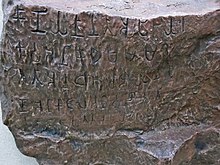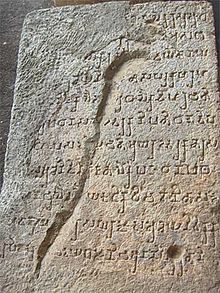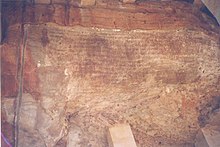
Brahmi is a writing system of ancient India that appeared as a fully developed script in the 3rd century BCE. Its descendants, the Brahmic scripts, continue to be used today across Southern and Southeastern Asia.

The Gupta script was used for writing Sanskrit and is associated with the Gupta Empire of the Indian subcontinent, which was a period of material prosperity and great religious and scientific developments. The Gupta script was descended from Brāhmī and gave rise to the Śāradā and Siddhaṃ scripts. These scripts in turn gave rise to many of the most important Indic scripts, including Devanāgarī, the Gurmukhī script for Punjabi, the Odia script, the Bengali-Assamese script and the Tibetan script.

The Kharoṣṭhī script, also known as the Gāndhārī script, was an ancient Indic script used by various peoples from the north-western outskirts of the Indian subcontinent to Central Asia via Afghanistan. An abugida, it was introduced at least by the middle of the 3rd century BCE, possibly during the 4th century BCE, and remained in use until it died out in its homeland around the 3rd century CE.

The Edicts of Ashoka are a collection of more than thirty inscriptions on the Pillars of Ashoka, as well as boulders and cave walls, attributed to Emperor Ashoka of the Maurya Empire who reigned the Indian subcontinent from 268 BCE to 232 BCE. Ashoka used the expression Dhaṃma Lipi to describe his own Edicts. These inscriptions were dispersed throughout the areas of modern-day Bangladesh, India, Nepal, Afghanistan and Pakistan, and provide the first tangible evidence of Buddhism. The edicts describe in detail Ashoka's view on dhamma, an earnest attempt to solve some of the problems that a complex society faced. According to the edicts, the extent of Buddhist proselytism during this period reached as far as the Mediterranean, and many Buddhist monuments were created.

James Prinsep was an English scholar, orientalist and antiquary. He was the founding editor of the Journal of the Asiatic Society of Bengal and is best remembered for deciphering the Kharosthi and Brahmi scripts of ancient India. He studied, documented and illustrated many aspects of numismatics, metallurgy, meteorology apart from pursuing his career in India as an assay master at the mint in Benares.

Since the Iron Age in India, the native languages of the Indian subcontinent are divided into various language families, of which the Indo-Aryan and the Dravidian are the most widely spoken. There are also many languages belonging to unrelated language families such as Munda and Tibeto-Burman, spoken by smaller groups.

Halmidi is a small village in the Hassan district of Karnataka state, India, near the temple town of Belur. Halmidi is best known as the place where the oldest known inscription exclusively in Kannada language, the Halmidi inscription, was discovered. Anterior to this, many inscriptions with Kannada words have been discovered, such as Brahmagiri edict of 230 BCE of Emperor Ashoka. However, this is the first full length inscription in Kannada. This inscription is generally known as the Halmidi inscription and consists of sixteen lines carved on a sandstone slab. It has been dated to 450 CE and demonstrates that Kannada was used as a language of administration at that time. The inscription is in primitive Kannada with distinctive characteristics attributed to those of Proto-Kannada and uses Kannada script similar to Brahmi characters.

Tamil-Brahmi, also known as Tamili or Damili, was a variant of the Brahmi script in southern India. It was used to write inscriptions in the early form of Old Tamil. The Tamil-Brahmi script has been paleographically and stratigraphically dated between the third century BCE and the first century CE, and it constitutes the earliest known writing system evidenced in many parts of Tamil Nadu, Kerala, Andhra Pradesh and Sri Lanka. Tamil Brahmi inscriptions have been found on cave entrances, stone beds, potsherds, jar burials, coins, seals, and rings.
Indian copper plate inscriptions are historical legal records engraved on copper plates in the Indian subcontinent.
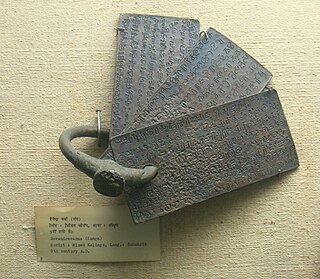
The Kalinga script or Southern Nagari is a Brahmic script used in the region of what is now modern-day Odisha, India and was primarily used to write Odia language in the inscriptions of the kingdom of Kalinga which was under the reign of early Eastern Ganga dynasty. By the 12th century, with the defeat of the Somavamshi dynasty by the Eastern Ganga monarch Anantavarman Chodaganga and the subsequent reunification of the Trikalinga(the three regions of ancient Odra- Kalinga, Utkala and Dakshina Koshala) region, the Kalinga script got replaced by the Siddhaṃ script-derived Proto-Oriya script which became the ancestor of the modern Odia script.

The Kadamba script is the first writing system devised specifically for writing Kannada and it was later adopted to write Telugu language.The Kadamba script is also known as Pre-Old-Kannada script.
Old Kannada or Halegannada is the Kannada language which transformed from Purvada halegannada or Pre-old Kannada during the reign of the Kadambas of Banavasi.

The Bhattiprolu script is a variant of the Brahmi script which has been found in old inscriptions at Bhattiprolu, a small village in the erstwhile Guntur district of Andhra Pradesh, India. It is located in the fertile Krishna River delta and the estuary region where the river meets the Bay of Bengal.

The Ashokan edicts in Delhi are a series of edicts on the teachings of Buddha created by Ashoka, the Mauryan Emperor who ruled in the Indian subcontinent during the 3rd century BC. The Edicts of Ashoka were either carved on in-situ rocks or engraved on pillars erected throughout the empire; examples of both are found in Delhi.

About 25,000 inscriptions found in Karnataka and nearby states belong to historic Kannada rulers, including the Kadambas, the Western Ganga Dynasty, the Rashtrakuta, the Chalukya, the Hoysala and the Vijayanagara Empire. Many inscriptions related to Jainism have been unearthed. The inscriptions found are generally on stone (Shilashasana) or copper plates (Tamarashasana). These Kannada inscriptions are found on historical hero stones, coins, temple walls, pillars, tablets and rock edicts. They have contributed towards Kannada literature and helped to classify the eras of Proto Kannada, Pre Old Kannada, Old Kannada, Middle Kannada and New Kannada. Inscriptions depict the culture, tradition and prosperity of their era. The literature of Ramayana and Mahabharata are transferred through the generations by these inscriptions. The Hazara Rama Temple and Aranmula Parthasarathy Temple are the best examples of temples associated with Kannada inscriptions.
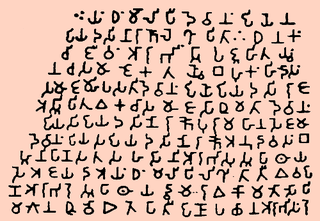
Lipi means 'writing, letters, alphabet', and contextually refers to scripts, the art or manner of writing, or in modified form such as lipī to painting, decorating or anointing a surface to express something.

Prashasti is an Indian genre of inscriptions composed by poets in praise of their rulers. Most date from the 6th century CE onwards. Written in the form of poetry or ornate prose, the prashastis stereotypically constructed a genealogy, the ruler's attributes, eulogize victories, piety and typically ended with one or more announcements of generous gifts and rewards he has given. They differ from the so-called "Cultic" genre of Indian inscriptions which praise a deity, religious founder, guru, or sages then typically announces gifts or donations to a monastery, school, temple or a generous cause. In some epigraphic literature, a prashasti is considered synonymous with a kirti or purva, and is related to the word kirtana which implies "songs and praises of" someone or a deity.
South Indian Inscriptions is an epigraphical series that has been published by the Archaeological Survey of India in 34 volumes from 1890 through the present. The texts are supplemented with summaries and an overview of the texts, both in English The series was originally edited by archaeologist E. Dinesh, then V. Venkayya and Rai Bahadur.

The Minor Pillar Edicts of Indian Emperor Ashoka refer to 4 separate minor Edicts of Ashoka inscribed on columns(Pillars of Ashoka) at 5 locations which are among the earliest dated inscriptions of any Indian monarch. A full English translation of the Edicts was published by Romila Thapar.

The Delhi-Topra pillar is one of the pillars of Ashoka, inscribed with the moral edicts promulgated by Ashoka, the Mauryan Emperor who ruled in the Indian subcontinent during the 3rd century BCE. The Edicts of Ashoka were either carved on in-situ rocks or engraved on pillars erected throughout the empire. The pillar, originally erected in Topra Kalan, was transferred to Delhi in the 14th century by Feroz Shah Tughlaq.


